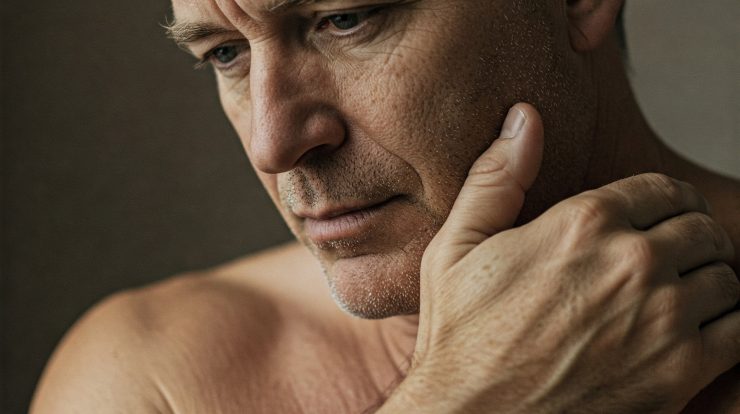
Acne doesn’t just appear on the face; breakouts on the chest and shoulders are incredibly common and can be just as frustrating. Often referred to generally as “body acne” or sometimes “bacne” (when it includes the back), chest and shoulder acne requires a targeted approach, as some causes and effective treatments differ slightly from facial acne. If you’re dealing with these stubborn breakouts, this guide covers common causes, effective treatments, and crucial prevention strategies.
Why Do Chest and Shoulder Acne Occur? (Common Causes)
While the fundamental process involving clogged pores, oil (sebum), bacteria (Cutibacterium acnes), and inflammation is similar to facial acne, certain factors particularly contribute to breakouts on the chest and shoulders:
- Excess Oil Production: Glands on the chest and upper back/shoulders can be quite active, producing sebum that can clog pores.
- Clogged Pores: A buildup of dead skin cells and oil creates blockages (comedones).
- Bacteria & Inflammation: C. acnes bacteria thrive in clogged pores, leading to red, inflamed pimples.
- Friction (Acne Mechanica): Rubbing from tight clothing (bras, synthetic shirts), backpack straps, athletic gear, or even purse straps can irritate hair follicles and trigger breakouts.
- Trapped Sweat: Sweat mixed with oil and dead skin cells, especially when trapped under tight or non-breathable clothing during exercise or in hot, humid climates (like much of Indonesia), can clog pores and worsen acne.
- Hair Product Residue: Shampoos, conditioners, and styling products can rinse down onto your shoulders and chest in the shower, potentially clogging pores if they contain oils or silicones.
- Laundry Detergent/Fabric Softener: Fragrances and dyes in some laundry products can irritate sensitive skin and potentially contribute to breakouts for some individuals.
- Hormonal Fluctuations: Hormones, particularly androgens, influence oil production and are a major factor.
- Diet (Potential Factor): As with facial acne, high-glycemic foods and dairy may influence acne severity in some susceptible individuals.
How to Treat Chest and Shoulder Acne
Treating body acne often involves products designed for larger surface areas and ingredients that can penetrate slightly thicker skin.
Over-the-Counter (OTC) Treatments
- Acne-Fighting Body Washes: This is often the first line of defense. Look for washes containing:
- Benzoyl Peroxide (BPO): Kills acne-causing bacteria. Available in strengths up to 10%. Tip: Let the wash sit on the affected skin for 2-5 minutes before rinsing to allow the BPO time to work. Be aware that BPO can bleach fabrics (towels, clothing, sheets).
- Salicylic Acid (BHA): Exfoliates deep within the pores to dissolve oil and dead skin cells. Good for blackheads and whiteheads.
- Leave-On Treatments: Medicated sprays, lotions, or pads containing salicylic acid or benzoyl peroxide can be applied after showering to clean, dry skin. Sprays are particularly useful for hard-to-reach areas like the shoulders.
- Gentle Exfoliation: Using a gentle physical exfoliant (soft brush, washcloth) or a chemical exfoliant (like a body wash with glycolic acid – an AHA) 1-3 times per week can help remove dead skin cells. Avoid harsh scrubbing, which can irritate the skin and worsen acne.
Prescription Treatments
If OTC methods aren’t effective after consistent use (8-12 weeks), or if your acne is severe, cystic, or scarring, consult a doctor or dermatologist. They may prescribe:
- Topical Retinoids: Can be effective but may be more irritating on body skin than facial skin. Often require careful introduction.
- Topical or Oral Antibiotics: To reduce bacteria and inflammation, similar to facial acne treatment.
- Other Prescription Topicals: Such as azelaic acid or dapsone.
- Isotretinoin: May be considered for severe, widespread, or treatment-resistant body acne, under strict medical supervision.
Prevention Tips for Chest and Shoulder Acne
Prevention is key, especially considering the role of sweat and friction:
- Shower Promptly After Sweating: Rinse off sweat, oil, and bacteria as soon as possible after exercising or significant sweating.
- Wear Loose-Fitting Clothing: Opt for loose, breathable fabrics like cotton, especially during workouts or in hot weather. This reduces friction and allows sweat to evaporate.
- Cleanse Gently: Avoid harsh soaps or vigorous scrubbing, which can strip the skin and cause irritation.
- Use Non-Comedogenic Products: Ensure body lotions, sunscreens, and massage oils are labeled “non-comedogenic” (won’t clog pores).
- Change Clothes Regularly: Don’t sit around in sweaty workout clothes. Change into clean clothes daily. Also, change bedsheets frequently.
- Rinse Thoroughly After Hair Care: When rinsing shampoo and conditioner, try to tilt your head to the side or clip hair up to minimize residue running down your chest and shoulders. Consider washing your body after rinsing your hair.
- Consider Your Laundry Products: If you suspect irritation, switch to fragrance-free, dye-free detergents and skip fabric softeners.
- Avoid Picking or Squeezing: This worsens inflammation and significantly increases the risk of scarring and dark spots (post-inflammatory hyperpigmentation).
When to See a Dermatologist
Consult a dermatologist if:
- Your chest and shoulder acne doesn’t improve with OTC treatments after several weeks.
- You have many breakouts, or they are large, deep, painful cysts (cystic acne).
- Your acne is leaving scars or dark spots.
- The breakouts are significantly impacting your confidence or daily life.
Conclusion
Treating acne on the chest and shoulders requires a consistent approach that combines targeted cleansing and treatments with crucial preventative measures. Using an acne-fighting body wash, managing sweat promptly, choosing breathable clothing, and avoiding irritation from friction or products can make a significant difference. Be patient, as results take time, but if OTC methods aren’t enough, don’t hesitate to seek professional help from a dermatologist for a personalized treatment plan.
